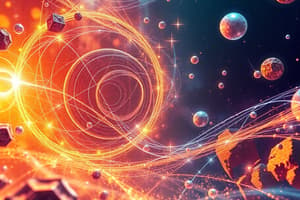Podcast
Questions and Answers
विद्युत चुम्बकीय बल किसके बीच क्रिया करता है?
विद्युत चुम्बकीय बल किसके बीच क्रिया करता है?
- केवल चुम्बकीय क्षेत्रों के बीच
- केवल विद्युत आवेशों के बीच
- विद्युत आवेशों और चुम्बकीय क्षेत्रों के बीच (correct)
- केवल गतिमान आवेशों के बीच
कौन सा सिद्धांत यह बताता है कि समय और स्थान एक साथ मिलकर अंतरिक्ष-समय बनाते हैं?
कौन सा सिद्धांत यह बताता है कि समय और स्थान एक साथ मिलकर अंतरिक्ष-समय बनाते हैं?
- थर्मोडायनामिक्स
- विशेष सापेक्षता (correct)
- विद्युत चुम्बकीयता
- सामान्य सापेक्षता
कुलंब के नियम का इस्तेमाल किसको समझने के लिए किया जाता है?
कुलंब के नियम का इस्तेमाल किसको समझने के लिए किया जाता है?
- विद्युत आवेशों के बीच बल (correct)
- प्रकाश की गति
- चुंबकीय बल
- गुरुत्वाकर्षण बल
कौन सी घटना सापेक्षता के सिद्धांत द्वारा समझाई जाती है?
कौन सी घटना सापेक्षता के सिद्धांत द्वारा समझाई जाती है?
किसका अध्ययन करने के लिए थर्मोडायनामिक्स महत्वपूर्ण है?
किसका अध्ययन करने के लिए थर्मोडायनामिक्स महत्वपूर्ण है?
क्लासिकल यांत्रिकी किसके बारे में बताती है?
क्लासिकल यांत्रिकी किसके बारे में बताती है?
न्यूटन के गति के दूसरे नियम के अनुसार, किसी वस्तु का त्वरण किस पर निर्भर करता है?
न्यूटन के गति के दूसरे नियम के अनुसार, किसी वस्तु का त्वरण किस पर निर्भर करता है?
क्वांटम यांत्रिकी में, ऊर्जा किस प्रकार मौजूद होती है?
क्वांटम यांत्रिकी में, ऊर्जा किस प्रकार मौजूद होती है?
थर्मोडायनामिक्स का दूसरा नियम क्या बताता है?
थर्मोडायनामिक्स का दूसरा नियम क्या बताता है?
निम्न में से कौन सा क्वांटम यांत्रिकी का एक प्रमुख सिद्धांत है?
निम्न में से कौन सा क्वांटम यांत्रिकी का एक प्रमुख सिद्धांत है?
Flashcards
शास्त्रीय यांत्रिकी
शास्त्रीय यांत्रिकी
पैमानों, वाहनों और लोगों जैसी बड़े पैमाने की वस्तुओं की गति का वर्णन करता है।
न्यूटन का पहला नियम
न्यूटन का पहला नियम
एक वस्तु केवल तब तक स्थिर रहेगी या गति में रहेगी जब तक कि उस पर कोई असंतुलित बल न लगे।
क्वांटम यांत्रिकी
क्वांटम यांत्रिकी
परमाणु और उपपरमाणु स्तर पर पदार्थ और ऊर्जा के व्यवहार का अध्ययन।
हीजेनबर्ग अनिश्चिता सिद्धांत
हीजेनबर्ग अनिश्चिता सिद्धांत
Signup and view all the flashcards
ऊर्जा का पहला नियम
ऊर्जा का पहला नियम
Signup and view all the flashcards
थर्मोडायनामिक्स
थर्मोडायनामिक्स
Signup and view all the flashcards
विद्युत्-चुंबकत्व
विद्युत्-चुंबकत्व
Signup and view all the flashcards
कुलंब का नियम
कुलंब का नियम
Signup and view all the flashcards
विशेष सापेक्षता
विशेष सापेक्षता
Signup and view all the flashcards
सामान्य सापेक्षता
सामान्य सापेक्षता
Signup and view all the flashcards
Study Notes
Classical Mechanics
- Classical mechanics describes the motion of macroscopic objects, such as planets, cars, and people.
- It's based on Newton's laws of motion and the law of universal gravitation.
- Key concepts include force, mass, acceleration, momentum, energy, work, and power.
- Newton's first law states that an object at rest stays at rest and an object in motion stays in motion with the same speed and in the same direction unless acted upon by an unbalanced force.
- Newton's second law states that the acceleration of an object is directly proportional to the net force acting on it and inversely proportional to its mass (F=ma).
- Newton's third law states that for every action, there is an equal and opposite reaction.
- Classical mechanics is extremely successful in describing many everyday phenomena.
Quantum Mechanics
- Quantum mechanics describes the behavior of matter and energy at the atomic and subatomic level.
- It's a probabilistic theory, meaning that it predicts the likelihood of an event rather than its precise outcome.
- Key concepts include wave-particle duality, quantization of energy, uncertainty principle, and superposition.
- Matter exhibits wave-like properties, and waves exhibit particle-like properties, illustrating this duality.
- Energy is quantized, meaning it can only exist in discrete values, not continuous ones.
- The Heisenberg uncertainty principle states that there is a fundamental limit to the precision with which certain pairs of physical properties of a particle, like position and momentum, can be known simultaneously.
- Superposition allows a quantum system to exist in multiple states simultaneously until measured.
- Quantum mechanics has revolutionized our understanding of the atom, atomic interactions, and much of modern technology.
Thermodynamics
- Thermodynamics studies the relationships between heat, work, and energy.
- It deals with macroscopic properties of systems and doesn't concern itself with the microscopic behavior of individual particles.
- Key concepts include heat, internal energy, temperature, entropy, and the laws of thermodynamics.
- The first law of thermodynamics states that energy cannot be created or destroyed, only transformed from one form to another.
- The second law of thermodynamics states that the total entropy of an isolated system can only increase over time.
- The third law of thermodynamics states that it is impossible to reach absolute zero temperature.
- Thermodynamics is crucial for understanding engines, refrigerators, and many other systems involving heat and energy transfer.
Electromagnetism
- Electromagnetism describes the interaction between electrically charged particles.
- Key concepts include electric charge, electric field, magnetic field, electromagnetic waves, and electromagnetic force.
- Electric charges exert forces on one another according to Coulomb's law, which describes the electrostatic force between point particles.
- Moving charges create magnetic fields.
- Changing magnetic fields create electric fields, demonstrating that electric and magnetic fields are intimately linked.
- Electromagnetic waves, such as light, are disturbances of the electric and magnetic fields that propagate through space.
- Electromagnetism is fundamental to many technologies, including radio, television, and medical imaging.
Relativity
- Relativity encompasses two major theories: special and general relativity.
- Special relativity deals with the relationship between space and time for objects moving at constant velocities relative to each other.
- Key concepts from special relativity include time dilation, length contraction, and the concept of spacetime.
- General relativity describes gravity as a curvature of spacetime caused by mass and energy.
- Key concepts from general relativity include the curvature of spacetime, black holes, and gravitational waves.
- Einstein's theory of relativity has profoundly altered our understanding of gravity and the universe.
Studying That Suits You
Use AI to generate personalized quizzes and flashcards to suit your learning preferences.




